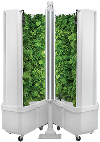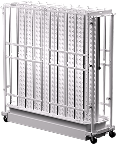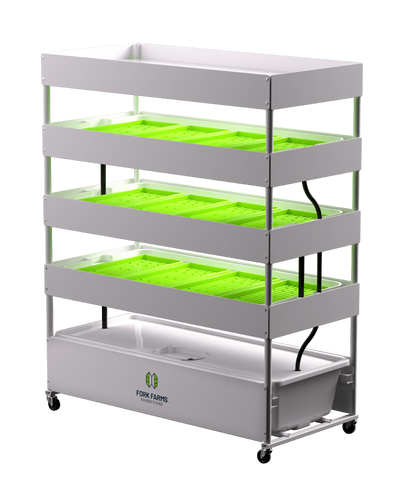Nutrient Formulas for Hydroponic Gardens: What are the Different Ways to Feed Plants Hydroponically?
There are various ways to feed hydroponic plants as well as several systems that are successful at feeding plants (we’ll tackle system options in a future blog post, so keep checking in). First things first - just like any other plant, hydroponic plants thrive when their basic needs are met. Hydroponic plants typically grow in gravel, clay pellets, or even just water where their roots are exposed to nutrient-rich water. The plants’ roots absorb nitrates and other essential nutrients, which enable them to grow.
What are the Essentials that Hydroponic Plants Need to Grow and Thrive?
Nutrients: Hydroponic plants gain nutrients via nutrient formulas dissolved in water instead of obtaining nutrients from soil. These special solutions contain essential macronutrients (nitrogen, phosphorus, potassium) and micronutrients (iron, calcium, magnesium, etc.) that are vital for plant growth. Ensuring the correct concentration of nutrients is fundamental for healthy growth.
Targeted pH Level: pH is the acidity of the water, and without the right acidity, the plants won't be able to absorb the nutrients. Regardless of how great your nutrient solution is, if your pH is off, plants won’t thrive. Generally, a pH range of 5.5 to 6.5 is suitable for most hydroponic plants.
Water: Since hydroponic systems use water as the method to deliver nutrients directly to the plant roots, a reliable and clean supply of water is critical.
Oxygen: Hydroponic systems should provide aeration and oxygen to plant roots. Most hydroponic setups often include mechanisms specifically for this purpose. For example, many hydroponic systems incorporate air stones and air pumps to oxygenate the nutrient solution.
Light: Just like traditional plants, hydroponic plants require light for photosynthesis. Typically in hydroponic growing, LED or fluorescent lights supplement natural light and support growth.
Temperature and Humidity: Most hydroponic plants thrive in temperatures between 65°F to 75°F (18°C to 24°C) and relative humidity levels around 60 percent.
Support: Depending on the type of hydroponic system used and the size of the plants, support structures, trellises or stakes may be necessary to ensure plants are properly anchored and can grow upright. Plus, human support such as regular monitoring and maintenance of the hydroponic system is necessary to ensure optimal conditions for plant growth. By providing these essential elements in the right balance, hydroponic plants can thrive and produce healthy yields.
What are the Top Nutrient Formulas and Ways to Feed Hydroponic Plants?
Introducing quality nutrient formulas to hydroponic plants is critical for their growth and productivity. There are several techniques and considerations to ensure plants receive the nutrients they need:
- Pre-mixed and Ready-to-go Nutrient Solutions. These are readily available formulas that contain a balanced mix of essential nutrients. Options are available in liquid concentrates, which are convenient, easy to use, and ideal for beginners or powdered nutrients, which are cost-effective but require mixing and dissolving.
- Custom or Homemade Nutrient Formulas. Experienced growers might prefer to create custom nutrient solutions tailored to the specific needs of their plants. Individual nutrient salts (potassium nitrate, calcium nitrate, etc.) can be purchased and mixed together for a custom recipe. Advanced growers can choose to make nutrient solutions from a homemade compost tea that serves as a way to auto-feed plants. Compost Tea is a natural fertilizer supplement for the roots that aids in the growth of plants.
- Aquaponics where aquaculture meets hydroponics. Aquaponics is a system that combines aquaculture (raising fish) and hydroponics in a mutual environment. Aquaponics feeds hydroponic plants by using fish waste as a natural and sustainable nutrient source. The natural nitrogen cycle, enabled by beneficial bacteria, converts fish waste into nutrients that can fuel plants. This creates a sustainable and efficient method of food production.
Through years of research, we have found that organic materials and fish waste are more difficult for a hydroponic system to manage. Systems need to be cleaned regularly as pumps and tubing get clogged more often, pH levels and nutrient balances are harder to control, food safety concerns increase, etc.
What we have found works best for plants in a hydroponic farm is a tested, and easy-to-use mineral nutrient fertilizer. It is always good to ask an expert for advice on which nutrient combination to use depending on what you're planning to grow in your garden. We recommend using nutrients from trusted brands that make products in the U.S. such as Jack’s Nutrients or Fork Farms that use high-quality nutrient formulas that are simple to administer, and specifically created and optimized for hydroponics. The nutrient formulas that we suggest for our Flex Farms have been tested and developed by hydroponic experts who have more than 50 years of experience. They are top-quality, mimicking nutrients that are found in natural soil and making the hydroponic growing process seamless and fruitful.
Here are the attributes we suggest looking for in a mineral solution for your hydroponic system:
- A salt-based nutrient solution that will help ionize and clean the water. This aids in offering clear readings for simple tracking of nutrient and pH levels
- A two-part nutrient plant formula as opposed to a one-part or three-part solution*. Two-part nutrient solutions have been around the longest in the industry and are the most cost-effective. They are commonly used in hydroponics to simplify the nutrient-mixing process. By breaking the solution into two parts, you are able to separate the core calcium and nitrogen from the rest of the other macro micronutrients. This prevents binding (or chemical reactions) and makes the nutrients last longer and work more successfully, leading to higher growth yield.
*One-part nutrient solutions are typically a one-size-fits all solution made for those who do not plan on growing a variety of bountiful foods. As an all-in-one option, they are easy to use, but typically cost more. They contain certain elements that bind with each other more quickly therefore inviting possible chemical reactions and reducing the shelf life of the product. Three-part solutions offer flexibility, but also more complexity. They are typically divided into grow, micro, and bloom formulas to cater to different stages of plant growth. With three parts, the grower has many more ratios and mixing to manage, which can be a more cumbersome process.
Optimized nutrition to plants yields better quality foods and more of these foods. Remember to select quality nutrient formulas, and then mix and deliver them appropriately. Regardless if you use pre-mixed solutions or create custom blends, the key is to ensure plants receive balanced nutrition. Healthy hydroponic systems also need regular monitoring and adjusting to continue to be productive and healthy.
Everyone can be a farmer. Let us help you grow. Get started growing with hydroponics.
Important Links:
























